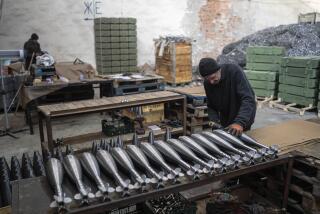Moscow Hopes to Overcome Tariff, Quality Hurdles : Wrenching a Niche in U.S. Tool Market
- Share via
CHICAGO — The Soviet Union wants to sell more machine tools to U.S. companies, but if it is to grab a larger share of the market it will have to improve quality and overcome high U.S. import tariffs, industry analysts said.
“There are drastic changes under way in our economy, and they improve the prospects for better foreign trade relations,” Vladimir K. Papanov, first deputy minister of the Soviet machine tool and toolmaking industry.
Papanov led a delegation to the current International Machine Tool Show here. With him were engineers, designers and industry executives on the prowl for industry contacts and customers.
Source of Hard Currency
The Soviet push is part of a Kremlin bid to open the Soviet economy and find a source of hard currency to build its supply of consumer goods, officials said.
Papanov said, for instance, that under perestroika, or economic restructuring, officials of Soviet industry can make direct contacts with foreign companies.
With the Soviet delegation were executives of Stan-Canada of Toronto, a firm that markets Soviet machine tools in Canada and plans to open a U.S. branch later this year.
But making a full-fledged run on the U.S. market will be difficult because potential U.S. customers believe the quality of Soviet-built hardware is uneven, and high U.S. tariffs on Soviet equipment imports make the goods prohibitively expensive, industry analysts said.
The Soviet Union does not have the so-called “favored-nation” status that Washington has granted to many other industrialized countries, so the import tariffs on Soviet goods are high.
Papanov said the U.S. tariffs, which range from 30% to 45%, will be a major impediment to improved U.S. sales unless reduced. “We know other countries don’t have the same high tariffs,” Papanov said.
Competes ‘in Other Countries’
Asked whether the Soviet Union could compete in the United States if the tariffs were removed, Pananov said he did not know but noted, “We do compete in other countries, such as Italy, Japan and Germany.”
Discussions between the two countries toward dismantling the tariffs are under way, he said. Papanov also said the Soviet government is discussing buys of U.S. machine tools and setting up joint ventures in either country with U.S. firms.
Paul Murphy, a Stan-Canada executive, said the U.S. market may be difficult to crack. “We have to persuade customers that Soviet-made machine tools are acceptable,” he said.
The Soviet Union sold about $8 million of machine tools in Canada in 1987 and will sell about $10 million this year. But less than $1 million in Soviet tools a year are sold through Stan-Canada to U.S. firms, Murphy said.
The Soviet moves come as U.S. demand for machine tools is rising because of high levels of factory utilization in many industries and because Detroit auto makers--the biggest customers for machine tools--are gearing up to develop new products, according to Ronald Petri, machine tool industry analyst at regional brokerage house McDonald and Co. in Cleveland.
Machine-Tool Demand
“In addition, the high level of product development among the Detroit auto makers and the establishment of Japanese-owned car manufacturing capacity in the U.S. will push up machine-tool demand next year and probably the year after,” Petri said.
The U.S. machine-tool industry alone, for instance, will get about 80% more orders this year than in 1987, according to James Gray, president of the Assn. for Manufacturing Technology, a U.S. trade group.
Gray, also interviewed at the trade show, did not seem too concerned about Soviet competition.
“The average quality is low,” he said. “But some Soviet machine tools are world class. They have a pretty good space program, so they’re capable of high technology.”
More to Read
Inside the business of entertainment
The Wide Shot brings you news, analysis and insights on everything from streaming wars to production — and what it all means for the future.
You may occasionally receive promotional content from the Los Angeles Times.










